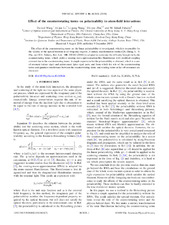| dc.creator | Wang, Da-wei | |
| dc.creator | Li, Ai-jun | |
| dc.creator | Wang, Li-gang | |
| dc.creator | Zhu, Shi-yao | |
| dc.creator | Zubairy, M. Suhail | |
| dc.date.accessioned | 2011-09-08T21:36:39Z | |
| dc.date.available | 2011-09-08T21:36:39Z | |
| dc.date.issued | 2009 | |
| dc.identifier.citation | Da-wei Wang, Ai-jun Li, Li-gang Wang, Shi-yao Zhu and M. Suhail Zubairy. Phys.Rev.A 80 063826 2009. "Copyright (2009) by the American Physical Society." | en |
| dc.identifier.uri | http://dx.doi.org/10.1103/PhysRevA.80.063826 | |
| dc.identifier.uri | https://hdl.handle.net/1969.1/126636 | |
| dc.description | Journals published by the American Physical Society can be found at http://publish.aps.org/ | en |
| dc.description.abstract | The effect of the counterrotating terms on the linear polarizability is investigated, which is responsible for the validity of the optical theorem in all frequency regions. A unitary transformation method [H. Zheng, S. -Y. Zhu, and M. S. Zubairy, Rev. Lett. 101, 200404 (2008)] is adopted to overcome the difficulty brought in by the counterrotating terms, which yields a rotating-wave-approximation-like Hamiltonian with modified coupling constant due to the counterrotating terms. A simple expression for the polarizability is obtained, which is a sum of resonant (minus sign) and antiresonant (plus sign) parts, and from which the role of the counterrotating terms and quantum interference between the counterrotating terms and rotating terms at far off-resonance are discussed. | en |
| dc.language.iso | en | |
| dc.publisher | American Physical Society | |
| dc.subject | Optics | en |
| dc.subject | Physics | en |
| dc.title | Effect of the counterrotating terms on polarizability in atom-field interactions | en |
| dc.type | Article | en |
| local.department | Physics and Astronomy | en |


